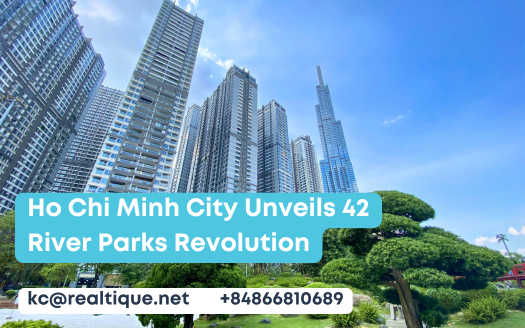Ho Chi Minh City Unveils 42 River Parks Revolution
Ho Chi Minh City is ready to initiate a significant urban change with the introduction of the River Park Revolution, a strategic initiative that aims to establish 42 parks along the Saigon River by 2045. This ambitious project seeks to enhance urban living conditions and ecological sustainability in key districts while addressing the growing demand for green spaces in a densely populated environment. As the city envisions a revitalized riverfront, the implications of this initiative extend beyond recreation—inviting a closer examination of its potential impact on local economies and community health. What challenges and opportunities lie ahead?
Table of Contents
Overview of the Development Plan
The development plan for Ho Chi Minh City encompasses a strategic initiative to create 42 parks along the Saigon River, aimed at enhancing both green spaces and economic importance within the urban environment.
Spanning from 2020 to 2045, this initiative focuses on key areas including Thủ Đức City, Districts 1, 4, 7, 12, Bình Thạnh, and two suburban districts.
The project aligns with the city’s extensive planning efforts, emphasizing sustainable development and improved urban living conditions.
By integrating green infrastructure, the plan seeks to provide multi-functional parks that not only serve recreational purposes but also strengthen local economies and enhance transportation networks.
This ambitious development aims to address the current shortfall in urban green spaces, nurturing a healthier ecological environment for residents.
Saigon River Features and Importance
Stretching over 256 kilometers, the Saigon River serves as a lifeline for Ho Chi Minh City, providing both ecological and recreational benefits.
Approximately 80 kilometers of the river flow through the city, featuring scenic islands and green spaces such as Thanh Đà and Thủ Thiêm. These natural vistas not only enhance the city’s aesthetic appeal but also support biodiversity and ecological balance.
The river is essential for local transportation, facilitating trade and movement within the thriving metropolis. Additionally, existing parks like Bạch Đằng and those in Vinhomes Central Park offer residents and visitors recreational opportunities, promoting community engagement and outdoor activities.
Goals for Park Development
Park development in Ho Chi Minh City aims to create multi-functional spaces that enhance transportation, tourism, and community interaction. The initiative focuses on integrating green infrastructure into urban planning, with a commitment to developing aesthetically pleasing environments that stimulate local economies.
Notably, the phased and segmented approach to park construction will guarantee efficient execution while addressing the pressing need for green spaces in a densely populated urban setting. Additionally, these parks are expected to improve air quality and support urban biodiversity, contributing positively to the overall environmental health of the city.
Land Use Strategies and Regulations
Effective land use strategies and regulations are essential for the successful development of parks along the Saigon River in Ho Chi Minh City. The initiative focuses on creating a harmonious balance between urban growth and green space, ensuring sustainable development while enhancing the area’s ecological and recreational provisions.
Key components include:
Designating riverbank areas for lively public spaces that invite community engagement.
Implementing flexible land use policies that accommodate both commerce and nature.
Establishing legal structures to facilitate seamless alteration of land use.
Developing sustainable practices to mitigate flooding and protect the environment.
These strategies aim to create a resilient urban environment that prioritizes green spaces, ultimately enriching the quality of life for residents and visitors alike.
Current Status of Urban Green Spaces
Ho Chi Minh City’s urban green spaces are currently facing significant challenges amid rapid urbanization and population growth.
With approximately 400 parks available, the city falls short of its green space goals, which aim for over 11,400 hectares. The average green space per capita is a mere 0.55 square meters, insufficient for a burgeoning urban population exceeding 10 million.
This deficit highlights the urgent need for strategic enhancements to existing parks and the creation of new green areas.
Current initiatives focus on revitalizing spaces along the Saigon River, emphasizing multifunctional parks that not only serve recreational purposes but also improve air quality and urban biodiversity.
Addressing these challenges is essential for elevating urban living conditions in Ho Chi Minh City.





